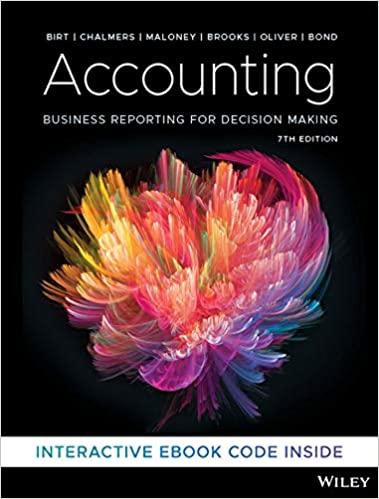Part A (a) Explain the advantages and disadvantages of the sole trader form of business structure compared
Question:
Part A
(a) Explain the advantages and disadvantages of the sole trader form of business structure compared to the partnership form of business structure. 4 marks
(b) Summarise the differences between a service and a manufacturing company. 2 marks
(c) Compare the liability requirements of members of a no-liability company and shareholders of a public company. 4 marks
(d) Describe the differences between a family trust and a unit trust. What are the tax advantages of the trust form of business structure? 6 marks
(e) Define limited liability. Provide an illustration of the term in relation to public companies. 2 marks
(f) What are the implications of the reduced disclosure regime for smaller companies: (1) to the entity; and (2) to other stakeholders? 4 marks
PART B
Ping and Juno decide to form a partnership on 30 June 2020. They secure the services of Timothy Legal to draw up their partnership agreement as follows.
1. Ping is to contribute:
• His car, the fair value of which is $32 000
• Property with a book value of $120 000, but revalued to $150 000
• A mortgage of $80 000; this was secured over the property and the partnership has agreed to assume this liability.
2. Juno is to contribute:
• Cash totalling $25 000
• Office equipment with a market value of $45 000.
It is also agreed that Ping will act as manager with an annual salary of $65 000, to be allocated at the end of each year. Profits or losses will be divided between Ping and Juno in the proportion 2/3 and 1/3 respectively.
Gross profit for the year ended 30 June 2021 is $165 000, with operating expenses of $105 000. Ping withdrew $19 500 and Juno withdrew $4000 during the year.
Required
(a) Prepare the statement of financial position of the partnership on its formation (30 June 2020). 8 marks
(b) Calculate each partner’s share of profit for the year ended 30 June 2021. 6 marks
PART C
The directors of Carlos Ltd provide you with the following financial information for the period ended 30 September 2019: selling expenses $96 000; occupancy expenses $12 000; finance expenses $26 400; loss due to legal action $5400; administrative expenses $20 400; cost of sales $180 000; ordinary share capital (100 000 shares issued) $300 000; sales revenue $720 000; other revenue $15 000; dividends declared (for current period) $14 400; retained earnings at beginning $258 000. Income tax is to be applied at a 30 per cent rate to profit before tax.
Required
(a) Prepare a statement of profit or loss for Carlos Ltd for the period ended 30 September 2019. 7 marks
(b) Determine the closing balance of retained earnings at 30 September 2019. 3 marks
(c) Public companies have to comply with extensive reporting regulations, including the Corporations Act and the ASX Listing Rules. Explain the reasons why public companies have additional regulations compared to proprietary companies and how the additional reporting disclosures assist different users in making decisions about the allocation of scarce resources. 4 marks.
Step by Step Answer:

Accounting Business Reporting For Decision Making
ISBN: 9780730369325
7th Edition
Authors: Jacqueline Birt, Keryn Chalmers, Suzanne Maloney, Albie Brooks, Judy Oliver, David Bond





